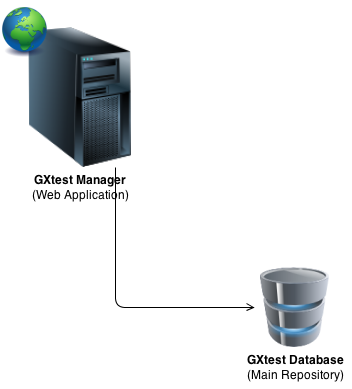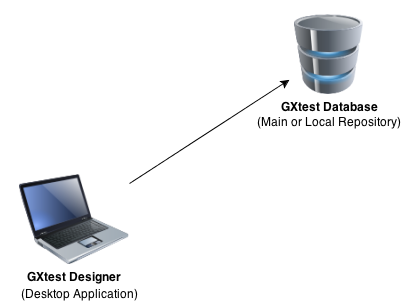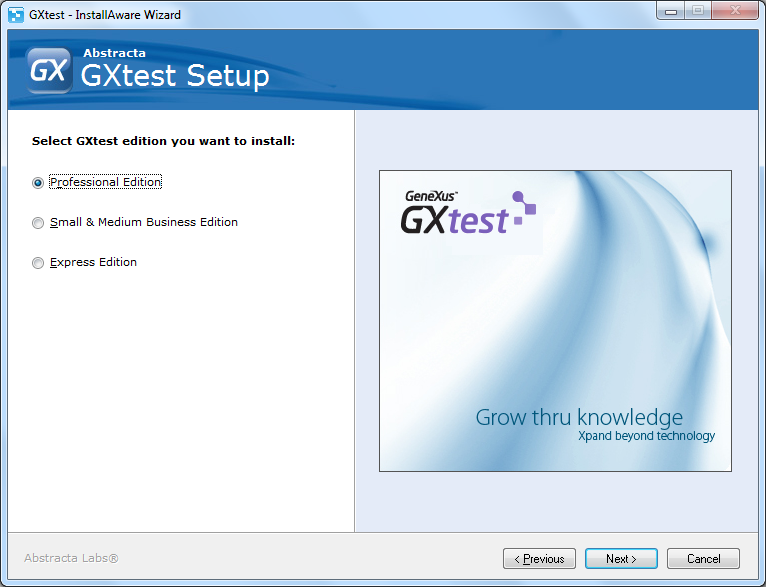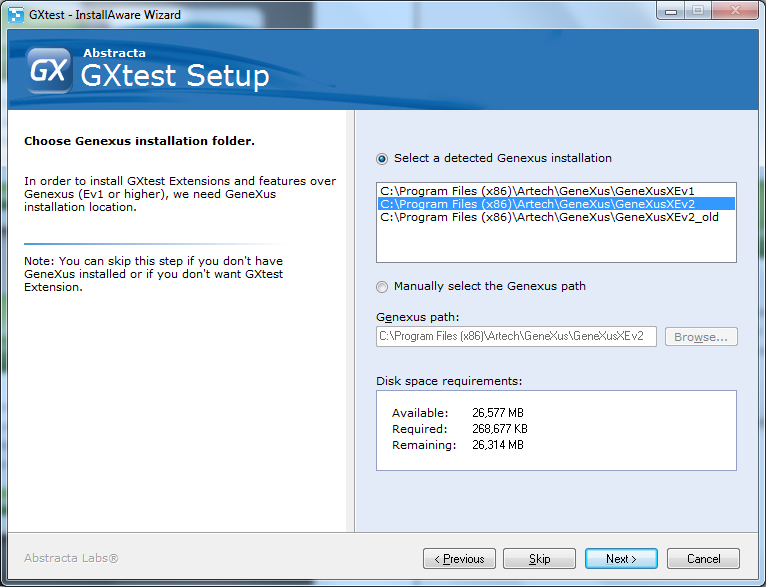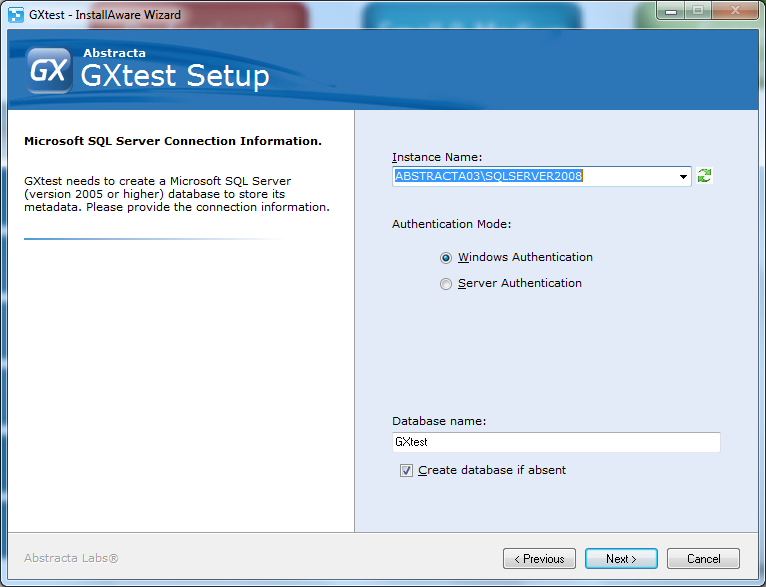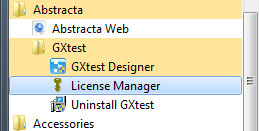Installation guide
Contents |
Introduction
Requirements for “Tester Client” installation
- Minumun Hardware : Pentium IV with at least 2 GB de RAM and 3 GB free HDD space. Wished: Intel i3 or higher.
- Operative System: Windows XP or higher.
- Software:
- .NET Framework 2.0 sp 2
- .NET Framekork 3.5
- Optional (recomended):
- Microsoft SQL Server 2005 or higher (also can be the Express version)
- Internet Explorer 8 or higher
Requirements for “Server Repository” installation
- Minumun Hardware : Pentium IV with at least 2 GB de RAM and 10 GB free HDD space. Wished: Intel i3 or higher.
- Operative System: Windows XP or higher.
- Software:
- .NET Framework 2.0 sp 2
- .NET Framekork 3.5
- IIS 6.0 or higher including ASP.NET
- Microsoft SQL Server 2005 or higher (also can be the Express version)
- Recomended:
- Microsoft SQL Server 2008 R2 or Microsoft SQL Server 2012
Resources (downloads)
- Download last GXtest version from: http://genexus.com/gxtest
- Microsoft SQL Server 2008 R2 (Express edition): http://www.microsoft.com/sqlserver/2008/en/us/R2Downloads.aspx
Note: This installation guide is for GXtest 2.0 (and higher) in english version.
Component Details
There are 5 products in GXtest's suite which can be installed either together or separately. Prior to installing it, it is necessary to understand its components as well as the technologies upon which they are based, in order to better understand the installation and configuration. Moreover, GXtest may have distributed components throughout several workstations, therefore, it is necessary to understand how they communicate with one another to properly configure them.
In the online documentation the solution for the most common installation problems as well as its solutions can be found, the address is gxtest.abstracta.com.uy and the information is available under the Support / Troubleshooting category.
1 - GXtest Manager
It is a website which installs in the IIS connecting to an SQL Server database (where the test cases are hosted). It is the central server which concentrates all of the tests which will be executed automatically.
2 - GXtest Designer
It is a Windows desktop application which connects to an SQL Server database, it is in it where all the test cases are stored. Typically, the installation takes place in the computer where the test cases will be designed, either by the tester or the developer. Also, it is possible to install it without a database and use GXtest Manager database as a unique repository for the test cases.
Se recomienda la instalación de un único repositorio al que acceda GXtest manager y todos los testers con sus instalaciones locales de GXtest Designer.
3 - GXtest Recorder
This product is an Internet Explorer extension, employed for recording the test cases in the application which will be automated. Additionally, it can also be installed as a stand-alone on any computer, for instance, it could be installed by an end-user to report bugs.
4 - GXtest Executor
The executor is the application which handles the execution of scheduled tests, and it is installedd in the workstations that were designated for running the tests. It is usually installed in the same workstations designated for GXtest Manager, though it is also common installing other instances to eiter distribute tests in parallel or in workstations solely dedicated for the execution of automated tests. Note: This is the one component with the largest hardware requirements, for it is the one where all tests will finally be running from.
5 - GXtest Daemon
This is product is installed as a Windows service along with the GXtest Manager and it accesses the same database. Also, it communicates with the GXtest Executor, and with as many as there may be installed and configured in GXtest Manager in order to request the execution of a new test.
Guide
The purpose of this guide, is explaining the necessary steps to follow in order to conduct any of the two typical installations available in GXtest: Tester Client and Server Repository.
Important: Provided some component in GXtest version is installed with a version lesser than 1.2, please, have them uninstalled before proceeding. The aforementioned process may be conducted by going to the Control Panel --> Add or Remove Programs.
Note: Uninstalling GXtest does not delete de database, therefore, while installing a new GXtest all of your previously created proyects, as well as your created test cases are kept.
The installation wizard consists of 4 major steps such as:
1. Choosing the edition (according to your license)
2. Choosing the type of installation (Tester Client / Server Repository / Custom)
3. Confirm the installation location for GeneXus (this step is optional)
4. Enter la location for the database server
Paso 1 - Elija la versión a instalar (de acuerdo a la licencia adquirida)
Las diferencias entre las versiones de licenciamiento de GXtest pueden consultarse en: GXtest Editions
Paso 2 - Elija el tipo de instalación
Las 2 instalaciones más típicas de GXtest son Tester Client y Server Repository. Los componentes y características de los mismos son:
Tester Client: Instalación cliente para testers o desarrolladores.
- GXtest Designer + Recorder: las 2 herramientas básicas para comenzar a automatizar casos de prueba y probar cómo estos ejecutan.
- Si GeneXus está instalado:
- GXtest Extension: Permite exportar la metadata de la KB hacia GXtest.
- GXtest Generator: Generación de pruebas automáticas para Patrones WorkWith o WorkWithPlus con un clic (sólo en Professional Edition)
Server Repository: Instalación full para repositorio central de pruebas.
- Tester Client (Recorder + Designer + Extension + Generator)
- GXtest Manager: Aplicación web para la gestión de las pruebas automatizadas, ambientes, agenda y distribución de pruebas.
- GXtest Executor: Cliente para ejecutar pruebas de regresión en forma desatendida (Agendadas por GXtest Manager)
Paso 3 - Confirmar ubicación de instalación de GeneXus (opcional)
Si en la máquina de instalación está GeneXus instalado, elija la versión que estará trabajando inicialmente para automatizar pruebas, para que GXtest instale la GXtest Extension y el generador automático en caso de la Professional Edition.
Paso 4 – Crear el repositorio de pruebas (local o remoto)
Este paso permite conectarse a SQL Server para conectarse a un repositorio existente o crear uno nuevo.
En la instalación “Server Repository” no debe saltearse, ya que en algún lado se deben guardar los casos de prueba.
En la instalación “Tester Client” es también recomendable crear una base de datos local y trabajar localmente, aunque también es posible conectarse directamente al servidor central de pruebas (Server Repository) si fue instalado previamente.
Paso 5 – Autorización de la licencia
Luego de culminada la instalación, para autorizar la licencia localmente abra GeneXus License Manager desde el folder de instalación de GXtest (Windows > All Programs > Abstracta > GXtest):
- Para autorizar siga el proceso de autorización tradicional de GeneXus. (leer más...)
- Si utiliza GeneXus Protection Server autorice la licencia en dicha instalación.
Si no encuentra los productos de GXtest en la lista de GeneXus License Manager, deberá ejecutar un archivo .reg (registro de windows) disponible en su instalación de GXtest, típicamente en: C:\Program Files (x86)\Abstracta\GXtest Designer\ prodGXtest.reg
Luego abra nuevamente GeneXus License Manager.
Por inconvenientes en la activación de la licencia contacte a su distribuidor o en su defecto enviando un email a claves@artech.com.uy
Paso 6 – Habilite GXtest Recorder
Luego de instalar recuerde habilitar la extensión (toolbar) de GXtest en Internet Explorer desde: View / Toolbars / GXtest Recorder
